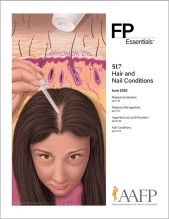
This clinical content conforms to AAFP criteria for CME.
A thorough understanding of nail anatomy can help physicians identify the causes of nail conditions. Observation of changes to the nail can help establish a diagnosis. Patient evaluation should include a physical examination, dermoscopy, and, in some cases, nail biopsy. Onychomycosis is the most common nail condition worldwide, and should be distinguished from other nail conditions with similar manifestations. Empiric onychomycosis treatment without confirmatory tests has been proposed, but studies have shown the cost-effectiveness of testing to prevent inappropriate therapy. Systemic drugs for management include terbinafine and itraconazole. Longitudinal melanonychia is a brown band through the length of the nail. Nail melanoma should be suspected if the band is dark brown-black, is located on a single digit, and occupies 40% or more of the nail plate width. Biopsy with local anesthesia should be performed in patients with suspected nail melanoma or other neoplastic nail conditions. Identification of warning signs of nail melanoma can result in earlier diagnosis and limit potential morbidity and mortality. Nail psoriasis often is overlooked but can affect up to 50% of patients with psoriasis. Nail lichen planus can cause permanent scarring with loss of normal nail anatomy. Other common nail conditions include acute and chronic paronychia, onychocryptosis, onycholysis, Pseudomonas infection (ie, green nails), onychogryphosis, subungual hematoma, and onychomadesis.
Already a subscriber?
Log In
Subscribe
From $350- Immediate, unlimited access to FP Essentials content
- 60 CME credits/year
- AAFP app access
- Print delivery available
Edition Access
$44- Immediate, unlimited access to this edition's content
- 5 CME credits
- AAFP app access
- Print delivery available
Interested in AAFP membership? Learn more
Learn More
